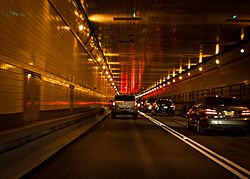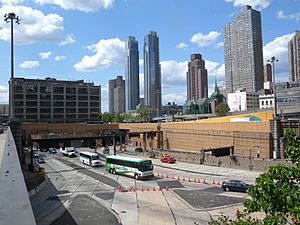Lincoln Tunnel facts for kids
 |
|
| Inside the tunnel | |
| Overview | |
|---|---|
| Location | Weehawken, New Jersey to Midtown Manhattan, New York City, US |
| Coordinates | 40°45′45″N 74°00′40″W / 40.7625°N 74.0111°W |
| Status | Open |
| Route | |
| Start | Weehawken, New Jersey |
| End | Manhattan, New York City, New York |
| Operation | |
| Owner | Port Authority of New York and New Jersey |
| Operator | Port Authority of New York and New Jersey |
| Traffic | Automotive |
| Character | Limited-access |
| Toll | (Eastbound only) As of August 29, 2019:
|
| Vehicles per day | 112,995 (2016) |
| Technical | |
| Construction | March 1934 – December 1937 (center tube) 1937–1938, 1941–1945 (north tube) 1954–1957 (south tube) |
| Length | 7,482 ft (2,281 m) (north) 8,216 ft (2,504 m) (center) 8,006 ft (2,440 m) (south) |
| Number of lanes | 6 |
| Operating speed | 35 miles per hour (56 km/h) |
| Lowest elevation | −97 feet (−30 m) |
| Tunnel clearance | 13 feet (4.0 m) |
| Width | 21.5 feet (6.6 m) |
The Lincoln Tunnel is an approximately 1.5-mile-long (2.4 km) tunnel under the Hudson River, connecting Weehawken, New Jersey, to the west with Midtown Manhattan in New York City to the east. It carries New Jersey Route 495 on the New Jersey side and unsigned New York State Route 495 on the New York side. It was designed by Ole Singstad and named after Abraham Lincoln. The tunnel consists of three vehicular tubes of varying lengths, with two traffic lanes in each tube. The center tube contains reversible lanes, while the northern and southern tubes exclusively carry westbound and eastbound traffic, respectively.
The Lincoln Tunnel was originally proposed in the late 1920s and early 1930s as the Midtown Hudson Tunnel. The tubes of the Lincoln Tunnel were constructed in stages between 1934 and 1957. Construction of the central tube, which originally lacked sufficient funding due to the Great Depression, started in 1934 and it opened in 1937. The northern tube started construction in 1936, was delayed due to World War II-related material shortages, and opened in 1945. Although the original plans for the Lincoln Tunnel called for two tubes, a third tube to the south of the existing tunnels was planned in 1950 due to high traffic demand on the other two tubes. The third tube started construction in 1954, with the delay attributed to disputes over tunnel approaches, and opened in 1957. Since then, the Lincoln Tunnel has undergone a series of gradual improvements, including changes to security and tolling methods.
The Lincoln Tunnel is one of two automobile tunnels built under the Hudson River, the other being the Holland Tunnel between Jersey City, New Jersey and Lower Manhattan. The Lincoln Tunnel is also one of six tolled crossings in the New York area owned by the Port Authority of New York and New Jersey. The tolls on each crossing are only collected in the New York-bound direction. As of 2016[update], both directions of the tunnel carry a combined average of 112,995 vehicular crossings every day. The tunnel is part of New Jersey Route 495 on the western half of the river, and New York State Route 495 on the eastern half of the river. However, the New York state highway designation is not signed, and its use is inconsistent in official documents.
History
The tunnel was originally to be named Midtown Vehicular Tunnel, but the planners eventually decided that the new tunnel deserved a name that was of similar importance to that of the George Washington Bridge, and named it after Abraham Lincoln.
Designed by Ole Singstad, the tunnel was funded by the New Deal's Public Works Administration. Construction began on the first tube (now the center of the three tubes) in March 1934. It opened to traffic on December 22, 1937, charging $0.50 per passenger car, equal to $10.18 today. The cost of construction was $85 million, equal to $1.86 billion today.
The original design called for two tubes. Work on a second tube, north of the first one, was halted in 1938 but resumed in 1941. Due to war material shortages of metal, completion was delayed for two years. It opened on February 1, 1945, with Michael Catan, brother of Omero Catan (known as Mr. First, attending over 526 opening day events), selected to be the first to lead the public through the tube.
A third tube was proposed by the Port Authority of New York and New Jersey due to increased traffic demand but initially opposed by the City of New York, which was trying to get the Port Authority to help pay for the road improvements that the City would need to handle the additional traffic. Eventually, a compromise was worked out, and the third tube opened on May 25, 1957 to the south of the original two tunnels. Although the three portals are side by side in New Jersey, in New York City the north tube portal is near Eleventh Avenue between 38th and 39th Streets. This portal is one block west of the other two tunnels' portals, which emerge side by side at Tenth Avenue between 38th and 39th Streets.
In 2012—the 75th anniversary of the Lincoln Tunnel and 85th anniversary of the Holland Tunnel in nearby Jersey City—the Hoboken Historical Museum held an exhibit in its Main Gallery called Driving Under the Hudson: The History of the Holland and Lincoln Tunnels, which explores the two tunnels' histories, and how they affected the region. Rutgers University professor Angus Gillespie, who wrote the 2011 book, Crossing Under the Hudson: The Story of The Holland and Lincoln Tunnels, served as a consultant for the exhibit's design.
Traffic
The three tubes comprise six traffic lanes in total and carries a combined total of almost 108,000 vehicles per day. During the morning rush hour, one traffic lane in the center tube called the "XBL" (exclusive bus lane) is used only by buses. The New Jersey approach roadway, locally known as The Helix, turns in a final half-circle before arriving at the toll booths in front of the tunnel portals. In Manhattan, Dyer Avenue and the Lincoln Tunnel Expressway serve as the primary egress roadways for the Lincoln Tunnel. Although the center tube normally provides one travel lane in each direction, both of the travel lanes in the tunnel's center tube are reversible and can be configured for peak-hour traffic demand if needed.
Normally, only motor traffic uses the tunnel, but every year, a few bicycle tours and foot races pass through by special arrangement.
The XBL is by far the busiest and most productive bus lane in the United States. The lane operates weekday mornings accommodating approximately 1,700 buses and 62,000 commuters, mainly to the Port Authority Bus Terminal. The ridership on the buses using the XBL is higher than that on New Jersey Transit's commuter rail into Penn Station.
Route numbering
With the cancellation of the Mid-Manhattan Expressway, intended to carry Interstate 495 through New York City to the Queens-Midtown Tunnel and the Long Island Expressway, the NYSDOT and NJDOT demoted the Lincoln Tunnel, Queens-Midtown Tunnel, and the freeway link to NJ 3 as state routes. Some signs still list the tunnels as I-495. Although the Federal Highway Administration still considers the Midtown Tunnel to be an Interstate, the Lincoln Tunnel is no longer on the Interstate system. In New Jersey, the freeway was officially demoted to NJ 495 and very few signs still read "I-495". In Manhattan, 34th Street links NY/NJ 495 and I-495.
As of 2012[update], the tunnel carries the unsigned NY 495 as well as NJ 495. The NY 495 designation applies to the part of the tunnel in New York, and vice versa for NJ 495.
Tolls
As of December 6, 2015, the cash tolls going from New Jersey to New York are $15 for cars and motorcycles; there is no toll for passenger vehicles going from New York to New Jersey. E-ZPass users are charged $10.50 for cars and $9.50 for motorcycles during off-peak hours (outside of 6–10 a.m. and 4–8 p.m. on the weekdays; and outside of 11 a.m.–9 p.m. on the weekends) and $12.50 for cars and $11.50 for motorcycles during peak hours (6–10 a.m. and 4–8 p.m. on the weekdays; and 11 a.m.–9 p.m. on the weekends).
Historically, the tolls were:
| Years | Toll | Toll equivalent in 2024 |
Notes |
|---|---|---|---|
| 1937–1970 | $0.50 | $3.77 – 10.18 | each direction |
| 1970–1975 | $1.00 | $5.44 – 7.54 | eastbound only |
| 1975–1980 | $1.50 | $5.33 – 8.16 | eastbound only |
| 1980–1987 | $2.00 | $5.15 – 7.1 | eastbound only |
| 1987–1991 | $3.00 | $6.45 – 7.73 | eastbound only |
| 1991–2001 | $4.00 | $6.61 – 8.59 | eastbound only |
| 2001–2008 | $6.00 | $8.16 – 9.92 | eastbound only |
| 2008–2011 | $8.00 | $10.41 – 10.87 | eastbound only |
| 2011–2013 | $12.00 | $15.08 – 15.61 | eastbound only |
| 2013–2014 | $13.00 | $16.07 | eastbound only |
| 2014–2015 | $14.00 | $17.28 | eastbound only |
| 2015 (Dec)– | $15.00 | $18.29 | eastbound only |
Images for kids
-
Entrance of the tunnel from Weehawken, New Jersey
-
The express highway to Lincoln Tunnel from the New Jersey Turnpike, which is part of New Jersey Route 495
See also
 In Spanish: Túnel Lincoln para niños
In Spanish: Túnel Lincoln para niños










